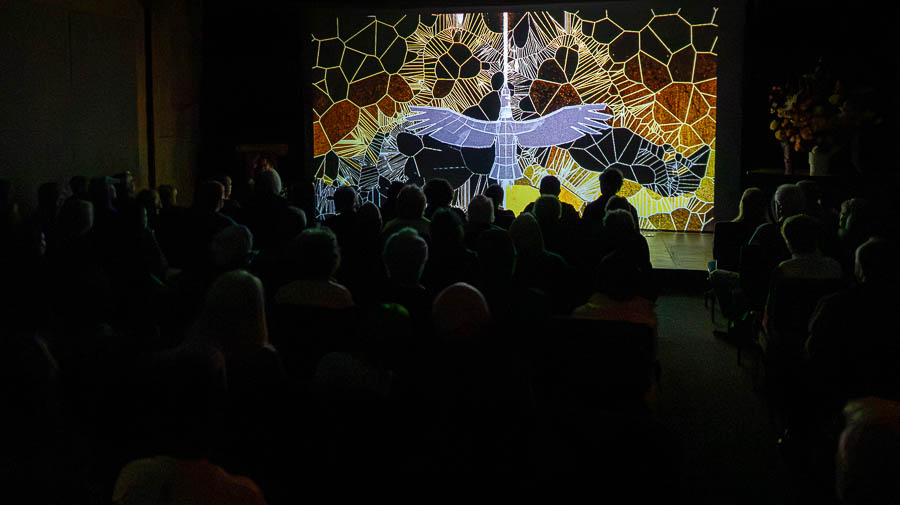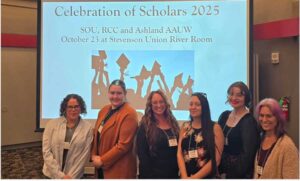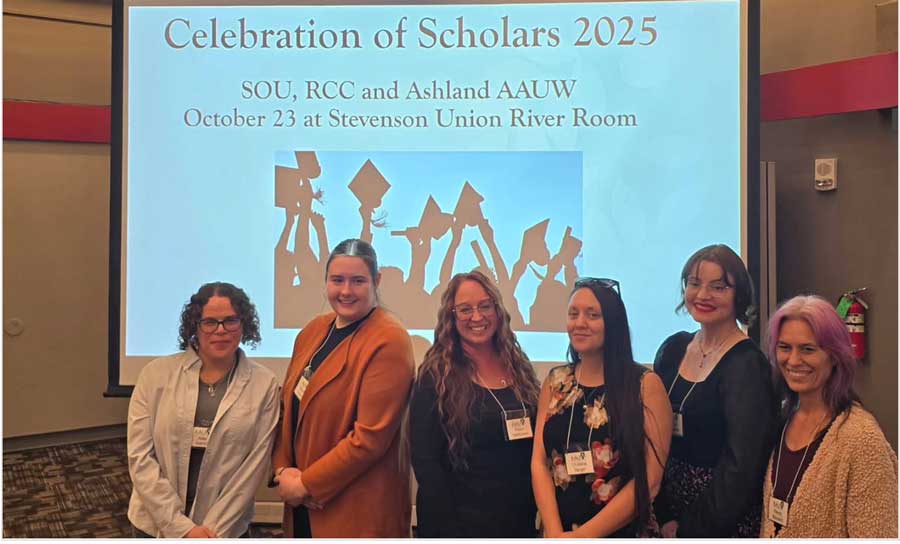Event included multimedia performance and collaborative art to raise awareness of threatened species
Give mercy to all broods and tribes,
Mercy to all nests and prides;
To tide and spring, squall and breeze,
To those who plead for calm and peace,
Not hunted, hounded, poisoned, fleeced
— From the Kyrie, “Mass for the Endangered,” Lyrics by Nathaniel Bellows
By Lucie K. Scheuer for Ashland.news
Rogue Valley residents were treated to a mystical, immersive experience at ScienceWorks Hands-On Museum in Ashland last weekend. It was the viewing of a visually mesmerizing short film entitled “Mass for the Endangered,” a digitally designed tribute to endangered animals, followed by the attendees’ engagement in an interactive art project. Participants were invited to “paint” special watercolor crayons onto blocks of vellum (a form of translucent paper) that contained images of imperiled animal species from the West Coast.
The completed tiles, evocative of stained glass, have been placed in an installation at the back of the museum in a temporary “Chapel for the Endangered,” which will be open for viewing through Jan. 4.
The afternoon was a collaborative effort presented by Anima Mundi Productions and ScienceWorks. Although there seems to be a religious connotation to the film and art project, there really isn’t. The “sacred” aspects are related to calling attention to the oneness of all things and the magnificence of creation.
The art installation is designed by local artist Karen Hanken, who spent over four months bringing hers, Ethan Gans-Morse’s, Tiziana DellaRovere’s, and ScienceWorks’ vision of marrying art with environmental awareness to fruition.
Sung by the Gallicantus singing group under the direction of Gabriel Crouch, “Mass for the Endangered” is not only a beautifully composed, flowing musical meditation incorporating Gregorian chant and polyphonic melodies – it invites the experiencer to enter into the divine through a series of ever-changing, kaleidoscopic images, based on sacred geometry.
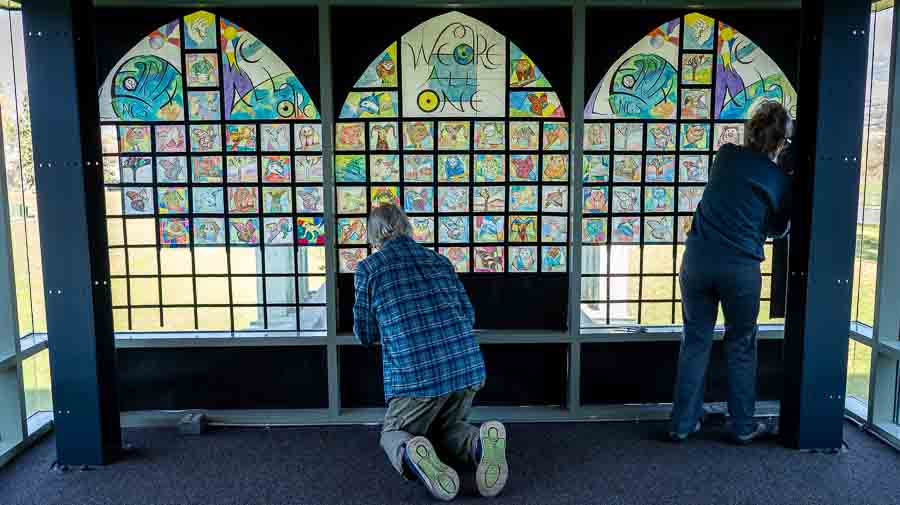
The music sequentially follows the traditional form of the Latin Mass: the “Ordinary,” which includes the “Kyrie,” “Gloria,” “Credo,” “Sanctus” and “Agnus Dei.” It also offers an “Alleluia,” making six parts of the montage cycle into one another.
Images are incorporated from the tree of life, found in Christian, Judaic, Buddhist and Celtic traditions. There are matrices of flora and fauna layered within circles. One is reminded of paintings by Henri Rousseau and Native American medicine wheels. Stunning images of water creatures under the moon, move through a dreamtime, overlaid with suggestions of pollution and spilled oil. It can be a bit repetitive, but it is always engaging.
“Mass for the Endangered,” composed by Sarah Kirkland Snider, premiered in September of 2020. Her works have been acclaimed by several publications, including the New York Times.
The moving libretto was composed by writer, visual artist and musician Nathaniel Bellows in Latin with incredible digital animation by animation artist Deborah Johnson.
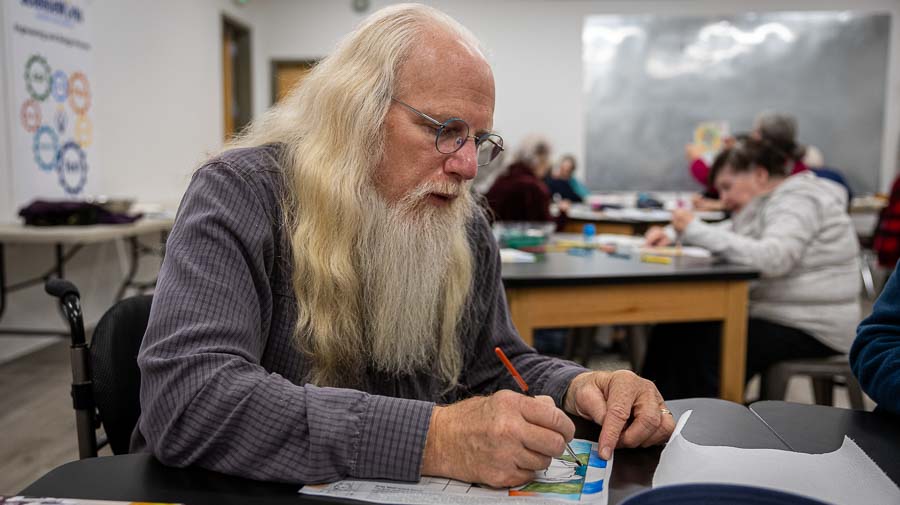
Anima Mundi says it is partnering with ScienceWorks to “offer opportunities for concert attendees of its nature-themed concerts, to learn about environmental sciences and how to be stewards of our natural world.”
Along those lines, and as part of the project, Anima Mundi is also partnering with Rogue Climate and youth mentor Adrian Chavez to run an art mentorship program for high-schoolers for this entire artistic season.
“On Sunday we brought them in to learn about ‘Mass for the Endangered.’ We fed them all pizza, and then they watched the film (their own private screening),” Gans-Morse said. “They were the first participants in the art installation project.”
ScienceWorks provided a list of the Pacific Northwest wildlife in danger: American Wolverine, Grizzly Bear, American Pika, Sierra Nevada Big Horn Sheep, Gray Wolf, Mountain Lion, Monarch Butterfly, Vaquita, Western Burrowing Owl, Oregon Spotted Frog, Mojave Fringe-toed Lizard, and the Joshua Tree.
The teens provided the center panels for the installation.
Textile artist Karen Hanken had been imagining something like this project for a long time. “I had attended the Anima Mundi season preview (back in May) after meeting Ethan through the Oregon Cultural Trust (OCT),” she said. “I had been volunteering as an ‘ambassador’ for the OCT.”

During that preview event, Hanken said Tiziana explained they wanted to do some sort of community art project but weren’t sure what that would be. “My brain started ticking on ‘what that would be,’ and as we walked around ScienceWorks, I started to envision a chapel window to coordinate with the stained-glass imagery of the film,” she says enthusiastically.
“I contacted Ethan, once I had this concept in mind, and we started working as a team to bring the project to fruition…. We met with the museum staff and presented the concept.”
Hanken says she knew it was all meant to be when she was a shown a room on the east end of the complex. It became the chapel. “I knew it was all going to be fabulous when completed.”
“We wanted to provide our audience with an opportunity to express themselves immediately after experiencing the film and Karen proposed a gorgeous companion piece that complemented the film perfectly,” Gans-Morse said. “We’ve been experimenting with offering more visual art and offering the public more ways to do art themselves, and Karen’s ‘Chapel for the Endangered’ brought that vision to life.”
Gans-Morse says those who want to learn about future opportunities to experience “Mass for the Endangered” can reach out to Anima Mundi by email at info@animamundiproductions.com.
Ashland resident Lucie K. Scheuer is a former copy editor and staff writer with the Los Angeles Times, where her work included features, reviews and a column on films in production. Email her at LucieScheuer19@gmail.com.




